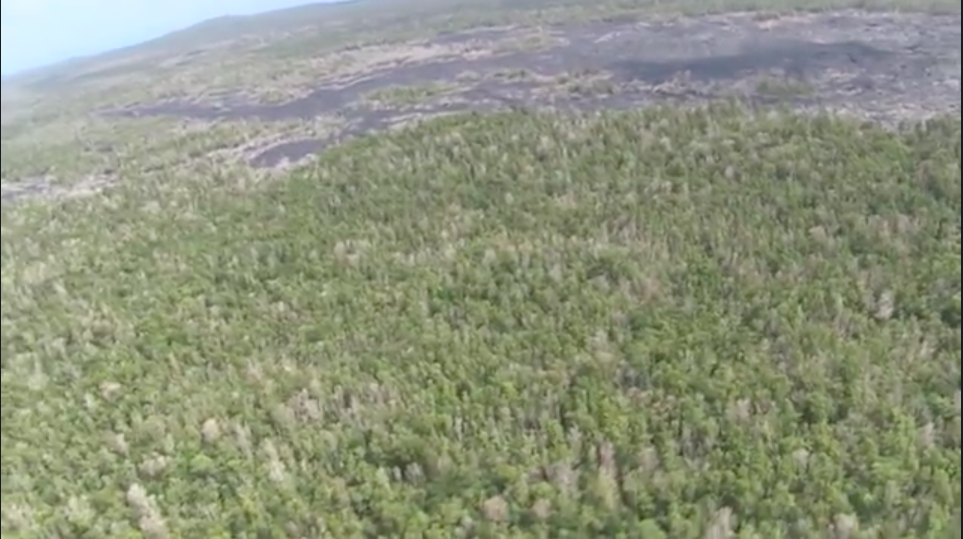05/27/16 – Soldiers In The Battle Against Rapid ‘Ōhi‘a Death; Passion for Hawaii Forests Prompts Participation
Posted on May 27, 2016 in Forestry & Wildlife, News Releases, sliderDEPARTMENT OF LAND AND NATURAL RESOURCES
News Release
| DAVID Y. IGE GOVERNOR |
SUZANNE D. CASE
CHAIRPERSON |
For Immediate News Release May 27, 2016
 (click on image to watch video)
(click on image to watch video)
SOLDIERS IN THE BATTLE AGAINST RAPID ‘ōhi‘a DEATH
Passion for Hawai’i Forests Prompts Participation
(HILO & KAHULUI) – Dozens of scientists, foresters, surveyors, researchers, and educators are actively involved in the fight to try and stop the spread of Rapid ‘Ōhi‘a Death. The fungal
disease has decimated tens of thousands of acres of native ‘ōhi‘a on the Big Island. A virtual army of specialists from a wide array of federal, state, county, and non-profit organizations are engaged in the fight to find a treatment and simultaneously to stop it in its tracks. That’s where education and outreach come in.
Anya Tagawa and Jeff Bagshaw of the DLNR Division of Forestry and Wildlife’s (DOFAW) Natural Area Reserve (NAR) program are two of the soldiers on the frontline of spreading awareness about Rapid ‘Ōhi‘a Death. They’ve each created signs that hunters, hikers, mountain bikers and other people recreating on state public lands will soon see. DLNR Chair Suzanne Case said, “It is critical that every person who goes into the woods or forest anywhere in Hawaii, takes steps to prevent this disease from spreading. Anya and Jeff’s work along with a team of other outreach experts, is vitally important in getting kama‘āina and visitors alike to be certain they don’t inadvertently track the fungus from place to place.”
Their individual signs are different in appearance, but contain the same basic message. Rapid ‘Ōhi‘a Death kills one of the most important native trees quickly and in wide swaths. Failing to follow the simple recommendations outlined on both signs could make you responsible for spreading this disease inter-island and intra-island.
Tagawa’s passion is borne of a life spent in the forest. She comments, “My life has always been intertwined with ‘ōhi‘a, with our native forests. I grew up hiking, exploring, and being captivated by our forests. I continue to learn about their unparalleled uniqueness and feel an intimate connection with these special places. Rapid ‘Ōhi‘a Death threatens this way of life. It is imperative that we do all what we can to ensure ‘ōhi‘a is present for our future generations to experience, engage, and form a relationship with. It is critical for the continued persistence of the countless unique plants and animals that rely on ‘ōhi’a.”
Bagshaw is the outreach coordinator at the Ahihi-Kina‘u NAR on Maui’s south shore. The nearest wild ‘ōhi’a is dozens of miles away yet he designed the sign for the Na Ala Hele Trails Access system, because he, like his colleagues, is deeply concerned about the fate of Hawai‘i’s ‘ōhi’a forests.
He said, “We hope hikers and all forest users will start to be conscious wherever they go, even if there’s ‘ōhi’a there or not. We’d like them to realize, that they could be taking something into the forest that affects our native ecosystems. ‘Ōhi’a are the backbone of our native rainforest; they feed the honeycreepers, they protect the watershed. I can’t imagine a Hawaiian rainforest without ‘ōhi’a.”
Recently, Bagshaw, his staff, and volunteers conducted awareness surveys with visitors to the Ahihi-Kina‘u NAR. They’ve found very few people have any knowledge about ōhi’a or Rapid ‘Ōhi‘a Death. They’re heartened though, by people’s willingness to adopt the preventative measures outlined on each of the trail signs.
Tagawa’s signs will eventually be at every DOFAW trailhead on the Big Island: more than 50 in all. On Maui, Bagshaw’s signs are being placed at all Na Ala Hele trailheads.
Media Contact:
Dan Dennison
Senior Communications Manager
(808) 587-0407